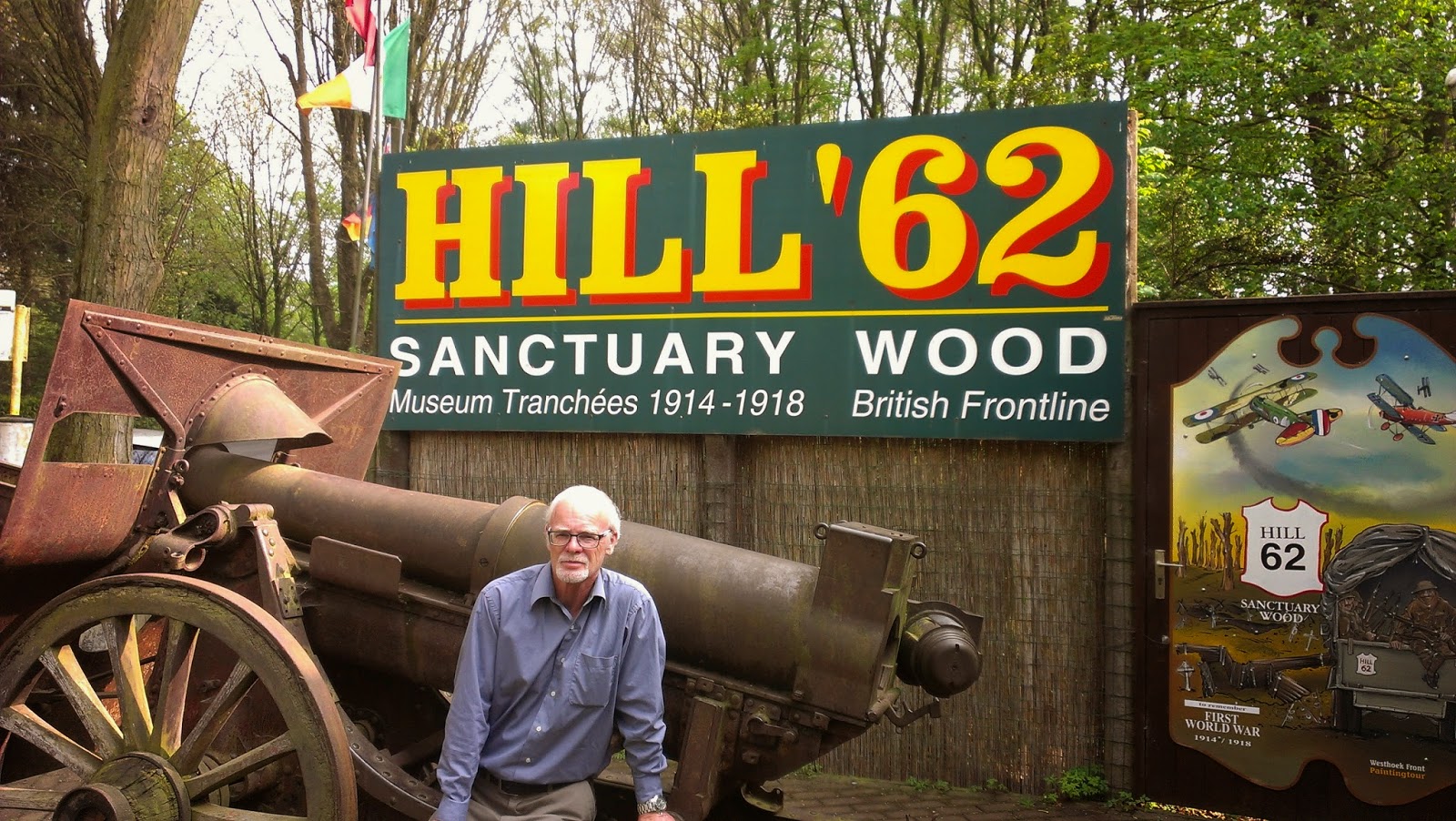His wet white face and miserable eyes
Brought nurses to him more than groans and sighs
But hoarse and low and rapid rose and fell
His troubled voice. He did the business well.
The ward grew dark, but he was still complaining
And calling out for 'Dickie. Curse the wood!
It's time to go. O Christ, and what's the good?
We'll never take it, and it's always raining.'
I wondered where he'd been, then heard him shout,
'They snipe like hell! O Dickie, don't go out'...
I fell asleep...Next morning he was dead,
And some Slight Wound lay smiling on the bed.
-Siegfried Sassoon
I had as a child visited the battlefields of France in the Verdun area, seen the Canadian monument at Vimy Ridge and walked the beaches of Normandy at the spot the Allies came ashore on D-Day, June 6, 1944. This was my first visit to the killing grounds of Ypres and hopefully I would finally understand the horrors my mother's dad, Bill Arman, experienced. Grandpop fought at Passchendaele, was gassed and suffered the rest of his life from his injuries, yet I never heard him complain or show any bitterness to those he went to war against in 1917.
Our first morning in Ypres, and after a wonderful and nourishing Belgium breakfast in our studio apartment, Marie and I set off down the cobbled street to the magnificently restored Cloth Hall housing the 'In Flanders Fields Museum'. We spent a few hours looking at an amazing collection of original maps, diaries, medals and all the many artifacts from WWI collected here during the last century. This was a special time to be here as the 100th anniversary of the war's opening shot will be celebrated this summer. Outside the Museum we boarded a small bus for an afternoon tour of the battlefields and cemeteries in the area. At the Tyne Cot cemetery, the largest Commonwealth memorial in the world where almost 12000 men lay, I found a wall with the names of those fallen who served with my Grandpop from the East Kent Regiment (The Buffs). It was quite a humbling moment for me as I stood before names that perhaps my Grandfather knew and called friends. We also stopped, in pouring rain that I felt appropriate for the location, in Langemarck cemetery, resting place of 44000 German soldiers. Oak trees towered over this sombre place and the presence of so many lost and tortured souls was disturbing. The sun reappeared as we left to continue our journey around the outskirts of town, passing through the beautiful Belgian countryside where farmers still occasionlly plowed up bones and bullets, stopping at the Canadian monument, the Brooding Soldier, and the museum at Hill 62, where we walked over and around actual trenches from the war. We returned to the Grote Markt square more appreciative of the sacrifices and suffering these warriors, now all gone, did for their countries.

 |
| Inside the Bell Tower, Cloth Hall |
 |
| view of Ypres from Bell tower |
 |
| Ypres in flames |
 |
| The Blue Max |
 |
| location where John McCrea wrote In Flanders Fields |
 |
| John McCrae Essex Farm Cemetery |
 |
| 15 year old Rifleman V J Strudwick |
 |
| 2 British soldiers mixed with German remains, Langemarck |
 |
| Langemarck Cemetery (German) |
 |
| Langemarck Cemetery |
 |
| gravestone marking resting place of 8 German soldiers killed in 1915 |
 |
| the Brooding Soldier Canadian monument |
 |
| Flanders Battlefield Tour bus |
 |
| Allied Hospital Bunkers |
 |
| East Kent Reg (The Buffs) Tyne Cot cemetery |
 |
| barbed wire and explosives |
 |
| Hill 62 actual trenches from WWI |
 |
| Marie with tour guide and passengers |
 |
| Brooding Soldier monument plaque |
 |
| Last fugitives in Ypres, 1915 |
The town of Ypres seemed oddly unreal to both of us as we strolled about that evening, admiring the architecture along narrow cobbled streets. We had learned earlier that what we were seeing was all built in the 1920's and later, after the war! The town itself, including the Cloth Hall, cathedral and every single home had been completely levelled by German shelling. After the war the King of Belgium and the residents of the town decided to rebuild exactly as it had been before 1914. It was amazingly accurate and so authentic that unless you knew differently you would think you had stepped back into the 13th century.
Our last night in Ypres we attended the nightly ceremony at the Menin Gate Memorial where the Last Post is played and colours presented. It was here the Allied troops set off for the front on the Ypres Salient. All the names etched into the walls on this memorial are those missing whose bodies were never recovered. Hundreds of people stood silent as the bugles notes floated mournfully out over the still evening air, a fitting end to our visit to the Town of Peace, as it is known now. I was glad to see the old rituals of remembrance still ring out everyday here in Flanders to a world thirsting for peace.
gws
If I should die, think only this of me! -
That there's some corner of a foreign field
That is for ever England...
Rupert Brooke, 1914
 |
| The Menin Gate |











































